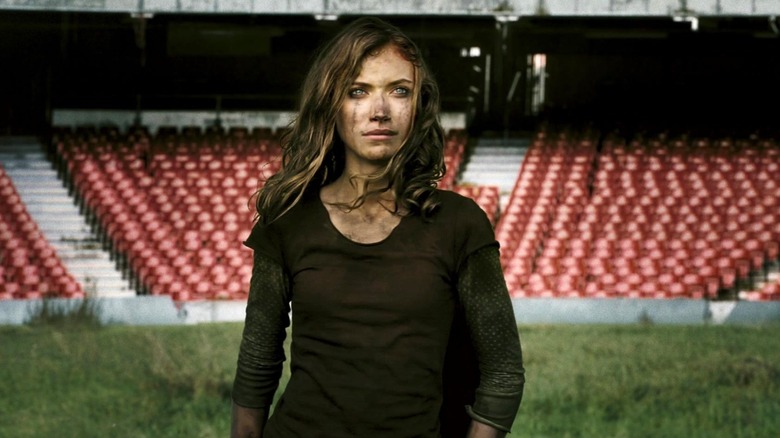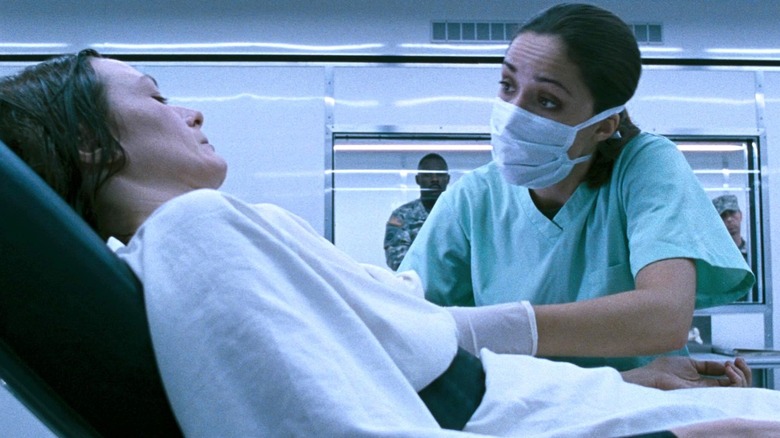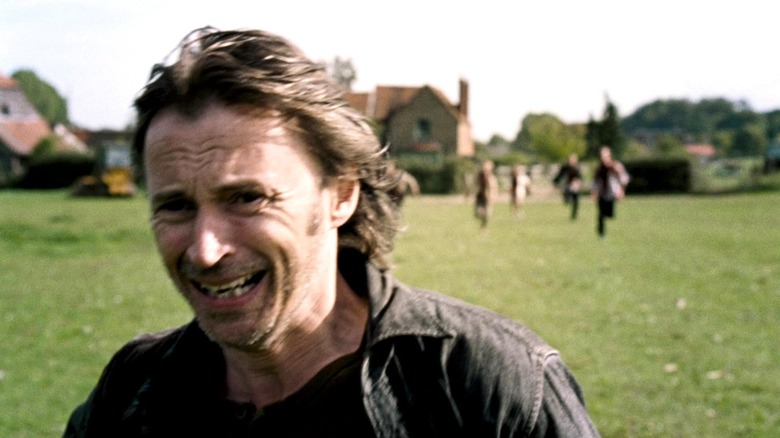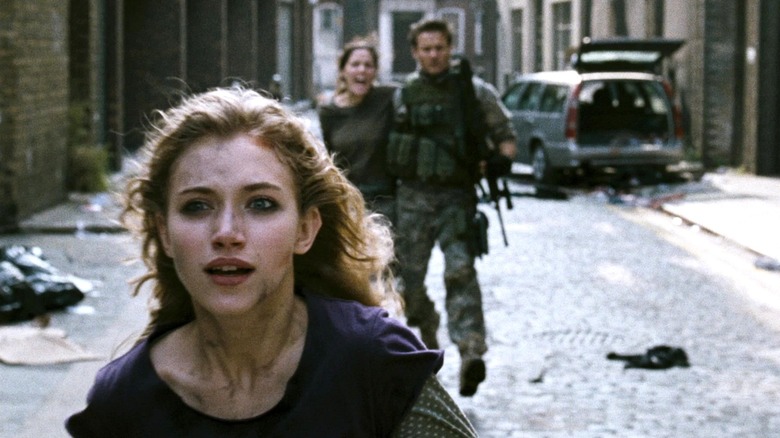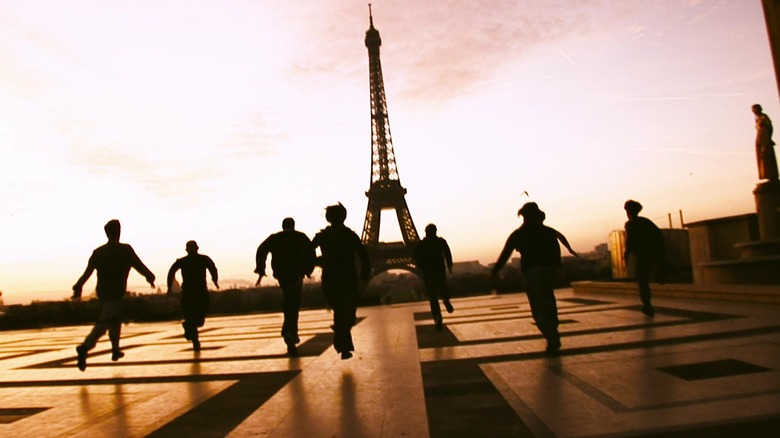28 Weeks Later Ending Explained: The Rage Is Reignited
We may receive a commission on purchases made from links.
One of Danny Boyle's best films, "28 Days Later" emerged as a jarring entry in the zombie-horror genre for several reasons. Primarily, the film introduced a brand of infected that defied conventional attitudes associated with the shuffling undead, as their hunger in this context is defined by uncontrollable, murderous rage. Aptly dubbed the Rage virus, this epidemic grips the streets of Britain and pushes this corner of the world towards an apocalypse, leaving scant survivors to reckon with a reality too brutal to comprehend. The true merit of "28 Days Later" is its ability to distill grounded apocalyptic fears into a visceral sense of dread, which is overcome and channeled into hope for humanity in the end.
This flickering hope is unceremoniously crushed in Juan Carlos Fresnadillo's "28 Weeks Later," which, as the title suggests, picks up exactly 28 weeks after the Rage virus outbreak. Although the sequel lacks the startling humanity of the original and retreads familiar territory within the confines of the genre, "28 Weeks Later" etches an even bleaker portrait of a civilization on the brink of collapse, with no silver lining to dull the edge of the knife. While Boyle's film promised the possibility of the infected gradually dwindling with more survivors being rescued and quarantined, the sequel reintroduces the virus with a renewed vigor, putting a whole new spin on the meaning of survival on a planet doomed to die out.
"28 Weeks Later" ends on a rather horrifying note — a warning, if you will — which underlines the inescapable nature of a virus that has now altered the genetic makeup of human beings. With no natural means to suppress rage anymore, the world now succumbs to unrestraint emotions that inevitably give way to unimaginable pain and suffering.
What you need to remember about the plot of 28 Weeks Later
Boyle's film ends with its leads surviving the epidemic, where the infected are seen dying due to starvation, with global authorities being alerted about the survivors. "28 Weeks Later" opens with couple Alice (Catherine McCormack) and Don (Robert Carlyle) hiding in a cottage alongside other survivors during the initial days of the outbreak. Glad that their kids Andy (Mackintosh Muggleton) and Tammy (Imogen Poots) are safe from the virus due to an out-of-state school trip, the pair aims to survive the outbreak by laying low on the outskirts of London. However, fate has other plans when they take in a distressed child and the infected follow, leaving no survivors except Don, who abandons his wife by escaping on a boat.
Fast-forward to 28 weeks after the outbreak. NATO forces attempt to rehabilitate survivors in safe zones, which is where Andy and Tammy are reunited with Don. The guilt of abandoning his wife weighs heavy on Don, but he doesn't have the courage to admit the truth. Instead, he clings to a fabricated story about Alice's death and suppresses his survivor's guilt in favor of a fresh start with his kids. However, unbeknownst to him, Andy and Tammy venture back to their parents' cottage to desperately search for any souvenir to keep the memory of their mother alive. This pure, delicate instinct births a terrible catastrophe when the kids find their mother living in the basement, and she is brought back to the safe zone's quarantine area.
An asymptomatic carrier of the Rage virus, Alice herself poses no threat to humanity until she unwittingly passes it on to a loved one, whose turn triggers a chain reaction that leads to the collapse of the hard-earned equilibrium in a rage-infected world.
An act of forgiveness breeds violence
"28 Days Later" underlined humanity, as opposed to the infected, as the source of true evil, where survivors, especially those meant to keep humanity safe, indulged in unspeakably cruel acts in the face of death. Calamity tends to accentuate baser impulses in us, as mortality is often re-contextualized in the face of a lawless and dying world. "28 Weeks Later" leans into this morbid impulse, albeit on an extreme micro level. Here, Don's split-second selfishness costs several lives including that of his wife, and no amount of regret seems nearly enough to dissipate this heavy guilt. After Alice is quarantined, Don seeks her out secretly, as he needs to convince himself that he is worthy of forgiveness and that there's still a chance for them to reconcile.
This confrontation culminates in a kiss, which, in the moment, is a symbol of new hope and forgiveness. This tender sentiment is, once again, morphed into something grotesque when Don becomes infected with the virus and turns, killing Alice and going on a rampage that only widens the scope of infection and endangers the survivors of the catastrophe. Perhaps, a twisted sense of justice is enacted when Don is infected — a price he pays for the startling lack of empathy he displays during the opening — but the repercussions prove to be dire when an entire safe zone becomes contaminated in a matter of seconds.
Unfortunately, the kids pay for the sins of their father, as the onus for saving the world falls on Andy, who turns out to be immune to the infection just like Alice, while Tammy needs to make sure that her brother survives the second outbreak until Scarlet (Rose Byrne) can make a cure.
What happened at the end of 28 Weeks Later?
The best post-apocalyptic stories often dive into the shifting vignettes of morality amidst extreme situations, especially ones that are contagious and immediate in nature. Pockets of power crop up haphazardly, and messy power struggles ensue, where groups fight for legitimacy in a hellscape where death seems kinder than being transformed into something unrecognizable. We see this in "The Last of Us," where the military guns down civilians without bothering to differentiate them from the infected and ends up contributing to greater tragedies in the long run.
In "28 Weeks Later," the U.S. Air Force makes a similar decision to firebomb an entire district to contain the second outbreak, making no effort to rescue survivors trapped in the area. Extreme situations demand extreme measures, but the cost of such brutal, effective strategies is human empathy, a sentiment nigh impossible to find even in the best of scenarios. However, U.S. sniper Doyle (Jeremy Renner) emerges as a ray of hope amid such bleakness, as he escorts the kids along with Scarlet to a safe area in order to help facilitate the possibility of a cure. This decision involves disobeying direct orders and endangering his own life, but Doyle and Scarlet firmly establish themselves as characters who do not sacrifice their empathy in exchange for survival. There's a zeal to believe in a greater purpose, in a greater good that negates personal desires, including the will to live.
In the end, both Scarlet and Doyle die, but they succeed in nudging the kids in the right direction, as they're able to reach Doyle's friend, Flynn (Harold Perrineau), at Wembley Stadium. While the kids are flown out of the country, their fates are left hanging in the air, with the faint promise of a cure teetering along the edge.
What the ending of 28 Weeks Later really means
If "28 Weeks Later" had ended on an ambiguous note, in which Andy and Tammy are last seen with Flynn on his helicopter, it would still encourage a future filled with the hope for a potential cure. As long as Andy does not end up infecting anyone as the dormant carrier of the Rage gene, he might be able to help with a cure that can completely reverse this genetic mutation among the infected. However, the film ends with a terrifying final frame: hordes of infected are seen in Paris, implying that the virus has now spread across Europe. What was once a devastating yet contained epidemic in Britain is now on the verge of becoming a global pandemic, with the prospects of a cure being left to pure chance.
Even if a cure is on the cards in a potential sequel, humanity still has to shoulder the weight of its own atrocities. Some people have to live with the guilt of killing their own, while others have to contend with the guilt of their own survival. Pain and loss are now deeply embedded into post-apocalyptic existence, and it is likely that there will be others like Andy who can silently host a pathogen without ever realizing that they can do so. This is arguably more dangerous than seeing an infected charge towards you in the dark, as these silent, unwitting methods of transmission can end up dooming humanity (where the beginning of the end gets triggered by an innocent kiss). The Rage simply has to follow.
"28 Weeks Later" is available to rent or purchase on Prime Video.
